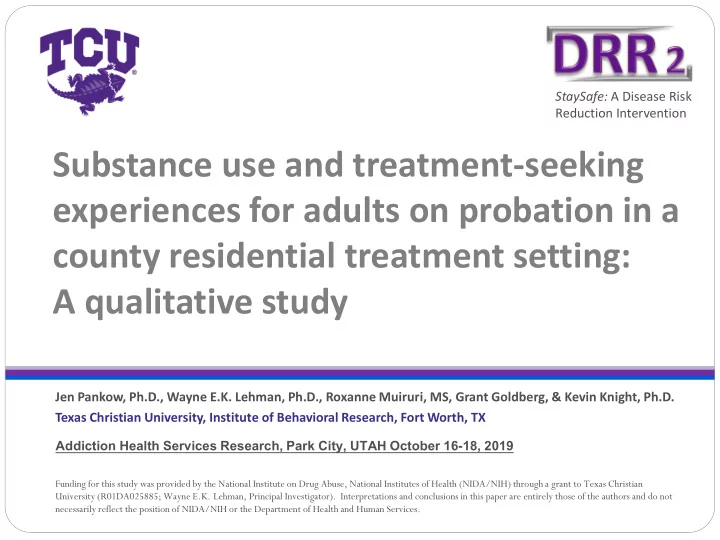

StaySafe: A Disease Risk Reduction Intervention Substance use and treatment-seeking experiences for adults on probation in a county residential treatment setting: A qualitative study Jen Pankow, Ph.D., Wayne E.K. Lehman, Ph.D., Roxanne Muiruri, MS, Grant Goldberg, & Kevin Knight, Ph.D. Texas Christian University, Institute of Behavioral Research, Fort Worth, TX Addiction Health Services Research, Park City, UTAH October 16-18, 2019 Funding for this study was provided by the National Institute on Drug Abuse, National Institutes of Health (NIDA/NIH) through a grant to Texas Christian University (R01DA025885; Wayne E.K. Lehman, Principal Investigator). Interpretations and conclusions in this paper are entirely those of the authors and do not necessarily reflect the position of NIDA/NIH or the Department of Health and Human Services.
Examine factors that influence substance use treatment-seeking Explore new topics to inform the current StaySafe curriculum and development of future prototypes Objectives
Qualitative Data o Focus groups : female and male (1 hour each) Semi-structured interview facilitated by senior-level researcher o Audio recorded, transcribed , and redacted o Codebook development (iterative process – 3 coders) o Intercoder agreement threshold- 85% o Atlas.ti version 8 o Inductive and deductive coding approach Methods
Focus Group Participants Males Females Demographics (N=6) (N=4) 29 Average age 43 19 - 38 Age range 25 - 59 9 - 24 Age of first drug use (range) 13 - 27 Primary Drug of Choice 3 Alcohol 1 0 Methamphetamine 1 2 Opioid (heroin) 0 0 Marijuana 2 1 Benzodiazepine (Xanax) 0
What factors influence treatment-seeking behavior? Research Question
Perceived Program Mandated Treatment Logistics Need Treatment Length of Hitting “rock stay bottom” Results “Choosing” Mandated Treatment
Well, when I first got here, you know – before I got here they offered me either five years [in prison] or this so I really didn't have no choice – I didn't choose this. Male Participant I didn't want to go to prison. I didn't want to be away from my family for ten years to be honest. [Choosing this program] was the quickest way of getting home. Male Participant When I was in County, going to court, I had my attorney fighting for [a shorter program]. I knew I needed treatment, but I didn't want to go six months. I just wanted to go when I wanted to go. Female Participant Length of Results stay Mandated Treatment
I was doing heroin and cocaine in prison…I finished my two- year sentence [and] I got caught by the police with some drugs on me so I went to jail. I went to see my lawyer and I told my lawyer that was it, I needed some help, can I get some rehab? So I asked for help . I wanted really to change because I wasn't going nowhere. Male Participant Self-reporting IV drug use (heroin, methamphetamine, and cocaine) Hitting “rock bottom” Results Mandated Treatment
I was tired and I wanted to get out, but I couldn't afford treatment. I just knew that I couldn't get out of this situation, this last go-round on my own. And so, it was an act of law enforcement. I mean, it was almost, it was a blessing. I don't know how to explain it. But it didn't necessarily come in the form that I wanted it to, but I've learned so much. Female Participant Self-reported 20-year addiction to methamphetamine Hitting “rock bottom” Results Mandated Treatment
Mandated substance use treatment and factors that influence program decision o Logistics: program duration 6-month treatment v. prison sentence • Time away from family o Perceived need for treatment “hitting rock bottom” - addiction severity Implications for gaining a better understanding about treatment readiness for individuals who are mandated to treatment Summarizing Factors that influence program choices
Are there new topics to inform future generations of StaySafe? Research Question
It's nerve-wracking when you think about – like, we're all ready to go home, but I know me personally, I'm nervous to go home because I'm not gonna have as much structure as I have now, and I'm not gonna have anybody to hold me accountable like I do now for what I do. So, I am kind of nervous to go home. Female Participant Results Program Structure – Female Participants
Just the simple fact that you've got to live by their rules. I've been on my own and I've been running my own business since I was 15 years old, so as far as having to listen and go to the restroom when I'm told to go to the restroom just didn’t work for me. Male Participant Some people like to power through us to be here. Yeah, it's like [counselors] have control over you basically. Male Participant Results Program Structure – Male Participants
Evidence pointing to the benefits of increasing or refining StaySafe content with more sensitivity to gender-specific themes: Females Males Self-efficacy Interpersonal skills Self-esteem Communication Assertiveness Listening Negotiation Future Directions
Questions? www.ibr.tcu.edu
Recommend
More recommend